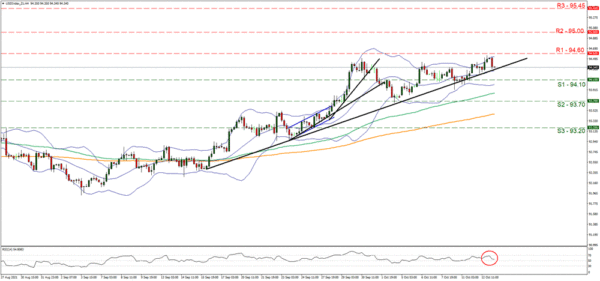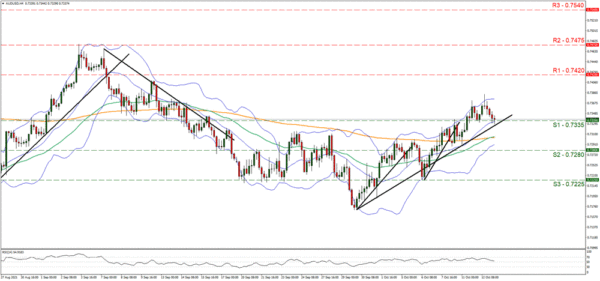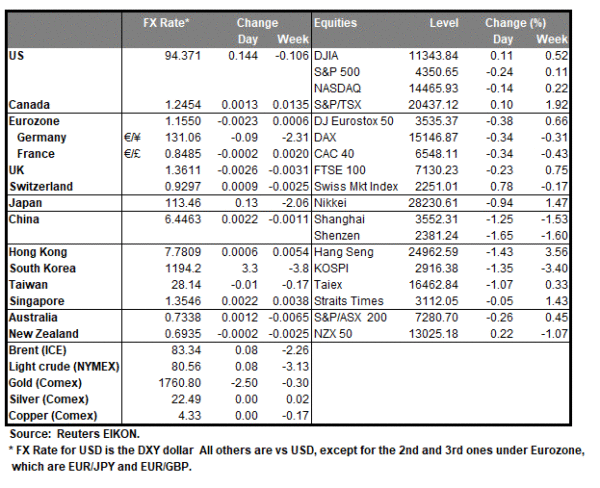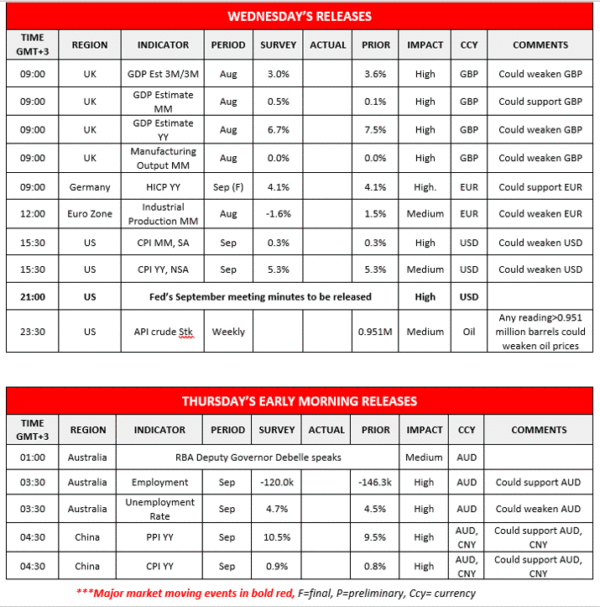The USD continued to rise against some of its major counterparts yesterday yet corrected somewhat lower during today’s Asian session. Market focus seems to shift to the release of the US CPI rates for September as well as the Fed’s September meeting minutes. Should the CPI release show that inflationary pressures in the US economy accelerated we may see the USD gaining as such a scenario could increase the pressure on the Fed to start tapering its QE program. On the monetary front we highlight the release of the Fed’s September meeting minutes later on in the American session. Any additional hawkish signals stemming from Fed policymaker’s statements could provide additional support for the USD. The big miss of the US NFP figure for September could give the Fed cold feet, but the drop of the unemployment rate to its lowest post-pandemic level could provide comfort and encouragement for the Fed to proceed with its tapering plans.
The USD index continued to be on the rise yesterday yet corrected lower during today’s Asian session. We maintain our bullish outlook for the index as long as it remains above the upward trendline incepted since the 16th of September. Please note that the RSI indicator seems to have neared the reading of 50, implying that the bullish sentiment may have eased somewhat. Please note that the index’s current levels constitute a one year high. If the USD continues to be in high demand as expected, we may see the index breaking the 94.60 (R1) line, thus paving the way for the 95.00 (R2) level. Should the index come under selling interest we may see it breaking the upward trendline prementioned and take aim if not breach the 94.10 (S1) line.
Aussie traders take a good look at employment data
AUD seemed to continue to be in the greens against the USD yesterday yet corrected lower during today’s Asian session. On a fundamental level the Aussie seems to be supported by higher energy prices as well as higher commodity prices. It should be noted though that China’s import growth rate decelerated considerably over the month of September, which is bad news for Australian exporters of raw materials. On the monetary front, RBA seems determined to maintain its dovish stance by hiking rates at the earliest in 2024, which could weigh on AUD. We expect that RBA deputy Governor Debelle’s planned speech during Thursday’s Asian session could stir considerable interest among Aussie traders. As for financial releases, we note the release of Australia’s employment data for September. Should the actual rates and figures meet their respective forecasts, as shown in the calendar below we see the case for bearish tendencies for AUD to be created. Main reason would be that the rates and figures point towards a slack in the Australian employment market as the unemployment rate rises and the employment change figure remains deep in the negatives despite its expected improvement.
AUD/USD corrected lower after peaking at an almost 1 month high. Yet for our bullish outlook to be altered we would require a clear breaking of the upward trendline incepted since the 30th of September. Please note the downward slope of the RSI indicator below our 4-hour chart as it slowly approaches the reading of 50, reflecting the easing of the bullish sentiment. Should the bears be in charge we may see AUD/USD breaking he 0.7335 (S1) support line, the prementioned upward trendline and aim for the 0.7280 (S2) level. Should the bulls remain in charge, we may see the pair aiming for the 0.7420 (R1) resistance line.
Today’s events and expectations
Today during the European session, we get from the UK, August’s GDP rates and from the Germany the final HICP rate for September and Eurozone’s industrial production for August. Just before Asian session starts we get from the US the API weekly crude oil inventories figure. During tomorrow’s Asian session, besides Australia’s employment data, we also get China’s inflation rates for September.
Support: 94.10 (S1), 93.70 (S2), 93.20 (S3)
Resistance: 94.60 (R1), 95.00 (R2), 95.45 (R3)
Support: 138.00 (S1), 135.60 (S2), 132.50 (S3)
Resistance: 142.00 (R1), 144.50 (R2), 146.80 (R3)


















